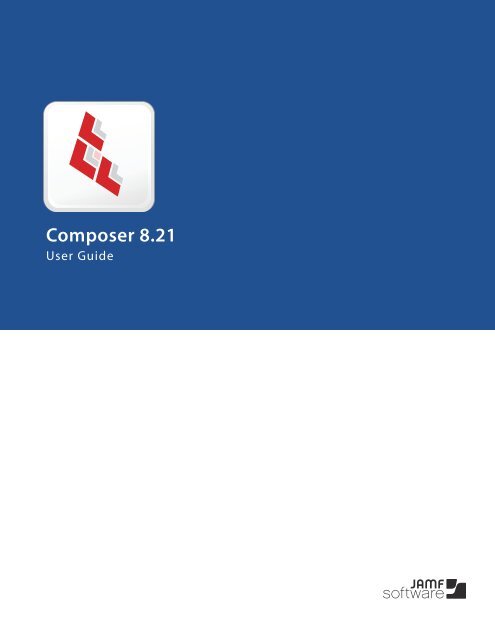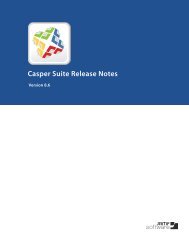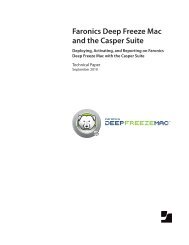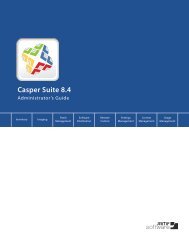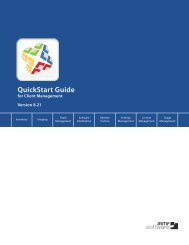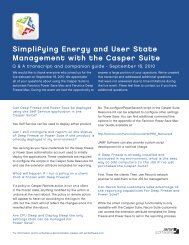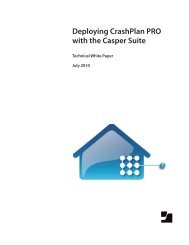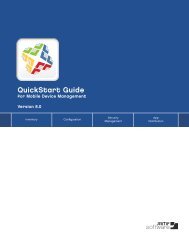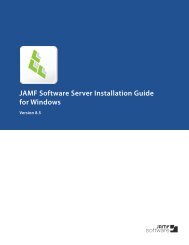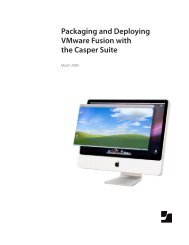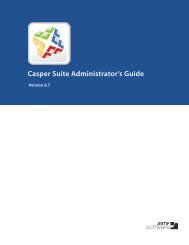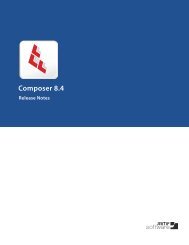Creating Packages - JAMF Software
Creating Packages - JAMF Software
Creating Packages - JAMF Software
You also want an ePaper? Increase the reach of your titles
YUMPU automatically turns print PDFs into web optimized ePapers that Google loves.
Composer 8.21<br />
User Guide
<strong>JAMF</strong> <strong>Software</strong>, LLC<br />
© 2011 <strong>JAMF</strong> <strong>Software</strong>, LLC. All rights reserved.<br />
<strong>JAMF</strong> <strong>Software</strong> has made all efforts to ensure that this guide is accurate.<br />
<strong>JAMF</strong> <strong>Software</strong><br />
1011 Washington Ave. South<br />
Suite 350<br />
Minneapolis, MN 55415<br />
(612) 605-6625<br />
Under the copyright laws, this publication may not be copied, in whole or in part, without the written<br />
consent of <strong>JAMF</strong> <strong>Software</strong>, LLC.<br />
Active Directory is a registered trademark of Microsoft Corporation in the United States and/or other<br />
countries.<br />
Apple, the Apple logo, Apple Remote Desktop, Finder, Leopard, Mac, Mac OS, and Open Directory are<br />
trademarks of Apple Inc., registered in the United States and other countries.<br />
Composer, the Composer logo, and the <strong>JAMF</strong> <strong>Software</strong> logo are trademarks of <strong>JAMF</strong> <strong>Software</strong>, LLC in<br />
the United States and other countries.<br />
The Firefox logo is a registered trademark of the Mozilla Foundation.<br />
Maker’s Mark is a registered trademark of Beam Global Spirits & Wine, Inc.<br />
All other product and service names mentioned are the trademarks of their respective companies.
Contents<br />
4 Introduction to Composer<br />
5 <strong>Creating</strong> <strong>Packages</strong><br />
5 <strong>Creating</strong> a Package Using Snapshots<br />
7 <strong>Creating</strong> a Package Using File System Monitoring<br />
9 <strong>Creating</strong> a Package Using Pre-Installed <strong>Software</strong><br />
11 <strong>Creating</strong> a Package by Dragging Contents from the Finder<br />
11 <strong>Creating</strong> a Package from an Existing Package File<br />
12 <strong>Creating</strong> an OS Package<br />
15 Editing a Package Source<br />
15 Viewing and Editing the Contents of a Package Source<br />
16 Adding Scripts to a Package Source<br />
18 Editing the Info.plist and Description.plist Files<br />
20 Adding Localizations to a Package Source<br />
23 Building a Package from a Package Source<br />
23 Building a PKG<br />
23 Building a DMG<br />
24 Managing Composer Preferences<br />
24 Work Directory and Package Preferences<br />
25 OS Package Preferences<br />
26 Exclusion List<br />
27 Glossary<br />
3
Introduction to Composer<br />
A package is a self-contained group of files that can be deployed to remote computers or as part of the<br />
imaging process. A package consists of product or component files, such as an application and its required<br />
components, a set of fonts, a preference file, or a document. A package also contains instructions about<br />
how and where it should be installed once received by the user.<br />
Depending on the files you want to package, Composer allows you to monitor the installation of your<br />
software or use files that already exist on your hard drive to build a package. You can also create a disk<br />
image of a pre-configured operating system.<br />
You can create packages using the following methods:<br />
Taking before and after snapshots of your hard drive<br />
Monitoring the file system<br />
Using pre-installed software<br />
Dragging contents from the Finder into Composer<br />
• Using an existing package<br />
Packaging an operating system (OS) package<br />
• <br />
Unless you are creating an OS package, the files or software you want to package must first exist as a<br />
package source in Composer. A package source allows you to view and edit attributes of the package<br />
(such as files, scripts, permissions, and localizations) before it is built. Once a package source exists for a<br />
group of files, you can make modifications and rebuild the package as many times as necessary. With the<br />
exception of OS packages, each method creates a package source in Composer for you.<br />
After you have verified the contents of a package source, Composer gives you the option to build a PKG or<br />
DMG-style package based on how you intend to use and deploy the package.<br />
4
<strong>Creating</strong> <strong>Packages</strong><br />
Depending on the nature of the files you want to package, Composer offers six different methods of<br />
package creation:<br />
• <br />
Snapshots—Composer takes before and after snapshots of your boot partition and builds a package<br />
source based on the changes. This method allows you to monitor installations in all locations on the<br />
boot drive. If necessary, you can also quit Composer or log out/reboot during the installation process.<br />
• <br />
File system monitoring—Composer uses the File System Events (FSEvents) framework to monitor<br />
any changes that are made to the file system during the installation process. A package is then built<br />
based on the changes. This method does not allow you to quit Composer or log in/reboot during the<br />
installation process. In addition, an excess of file system activity can cause FSEvents to miss changes.<br />
• <br />
Using pre-installed software—<strong>Software</strong> or files that are pre-installed on your computer can be built<br />
into a package based on Composer’s bundled diff files. This method allows you to build packages<br />
without monitoring the installation process.<br />
• <br />
• <br />
• <br />
Dragging contents from the Finder—A simple drag-and-drop process allows you to package files<br />
already installed on your computer.<br />
Using an existing package—Composer allows you to make modifications to an existing package or<br />
convert between the PKG and DMG package formats.<br />
Packing an operating system (OS package)—You can create disk images of pre-configured operating<br />
systems to enhance consistency across your network. Special preferences can be set to ensure the<br />
removal of unnecessary files before Composer created the disk image.<br />
This section explains how to create packages using these six methods.<br />
<strong>Creating</strong> a Package Using Snapshots<br />
If the files you want to package are not already installed on your hard drive, Composer can take a snapshot<br />
of your boot partition before and after the files have been installed and create a package source based on<br />
the changes.<br />
Composer can take two kinds of snapshots:<br />
• Normal snapshots—These snapshots capture any new files on the boot drive. These snapshots can take<br />
anywhere from ten seconds to several minutes depending on your hardware and the number of files<br />
on your boot drive.<br />
• New and modified snapshots—These snapshots capture any new files on the boot drive, as well as any<br />
files that have been modified.<br />
These snapshots can take longer than normal snapshots, since Composer records the modifications date<br />
of each file while performing the snapshot.<br />
There are a several benefits to using the snapshot approach:<br />
Composer monitors installations in all locations on the boot drive.<br />
You can quit Composer during the installation process.<br />
• <br />
You can logout or reboot during the installation process. 5
• <br />
If you delete a file while making modifications to a package source, it may be possible to restore the<br />
deleted file. For more information about restoring deleted files, see the “Editing a Package Source”<br />
section.<br />
To create a package using snapshots:<br />
1. Open Composer and authenticate locally.<br />
2. Click the New Package icon in the toolbar (Command + N).<br />
3. Under the Monitor Installation heading in the sidebar, select Snapshot.<br />
4. Select Normal Snapshot or New & Modified Snapshot in the New Package pane.<br />
5. Click the button labeled Choose.<br />
6. Enter a name for the package and click Begin.<br />
7. Install and configure your software, and then click the Build Package button to initialize the “after”<br />
snapshot.<br />
6
8. Under the Sources list in the sidebar, select the package source to verify its contents or make<br />
modifications. For details, see “Editing a Package Source.”<br />
9. Click the Build as DMG or Build as PKG button to build your package.<br />
See “Building a Package from a Package Source” for details on PKG and DMG-style formats.<br />
<strong>Creating</strong> a Package Using File System Monitoring<br />
When creating a package using file system monitoring, Composer uses the File System Events (FSEvents)<br />
framework that is built into Mac OS X to monitor any changes that are made to the file system. Each time<br />
a change is made, FSEvents receives a notification. After your software is installed, Composer analyzes the<br />
changes and builds a package source based on the results.<br />
The following limitations should be taken into consideration monitoring the file system to build a package:<br />
You cannot quit Composer during the installation process.<br />
• You cannot log in or restart during the installation process.<br />
It is possible for FSEvents to miss events if there is too much file system activity.<br />
• <br />
To create a package using file system monitoring:<br />
1. Open Composer and authenticate locally.<br />
2. Click the New Package icon in the toolbar (Command + N).<br />
3. Under the Monitor Installation heading in the sidebar, select Snapshot.<br />
7
4. Select Monitor File System Changes in the New Package pane.<br />
5. Click the button labeled Choose.<br />
6. Enter a name for the package and click Begin.<br />
7. Install and configure your software, and then click the Build Package button.<br />
8
8. Under the Sources list in the sidebar, select the package source to verify its contents or make<br />
modifications. For details, see “Editing a Package Source.”<br />
9. Click the Build as DMG or Build as PKG button to build your package.<br />
See “Building a Package from a Package Source” for details on PKG and DMG-style formats.<br />
<strong>Creating</strong> a Package Using Pre-Installed <strong>Software</strong><br />
If the software you want to package is already installed on your computer, Composer can scan your<br />
hard drive to determine which software it can package based on bundled diff files. If a diff file exists in<br />
Composer for software that is currently installed on your computer, it can be used to build a package. Any<br />
software that can be packaged will be displayed in the Contents pane of the New Package window.<br />
Note: Composer comes with diff files for over 100 different software titles and preferences. If there is<br />
software you would like to see added to Composer’s diff options, email your recommendations to diffs@<br />
jamfsoftware.com.<br />
To create a package using pre-installed software:<br />
1. Open Composer and authenticate locally.<br />
2. Click the New Package icon in the toolbar (Command + N).<br />
3. Under the Preinstalled heading in the sidebar, select <strong>Software</strong> or User Environment.<br />
Choosing <strong>Software</strong> (Command + 3) displays a list of titles that can be built into a package.<br />
• Choosing User Environment (Command + 4) displays a list of preferences that can be bundled into a<br />
package.<br />
9
4. Select the item(s) you want to package, and then click the Choose button.<br />
5. Under the Sources list in the sidebar, select the package source to verify its contents or make<br />
modifications.<br />
For details, see “Editing a Package Source.”<br />
6. Click the Build as DMG or Build as PKG button to build your package.<br />
See “Building a Package from a Package Source” for details on PKG ad DMG-style formats.<br />
10
<strong>Creating</strong> a Package by Dragging Contents from the Finder<br />
If you already know which item you want to package, you can bypass the snapshot or monitoring process<br />
by dragging items from the Finder to the Sources list in Composer.<br />
There are a few ways Composer handles these items:<br />
• If the item is a package file (with a .dmg, .pkg, or .mpkg extension), it is listed in the sidebar under the<br />
Package heading.<br />
• If the item is a folder, the root of the folder is used as the root of the package if the root is one of the<br />
following directories:<br />
• /Applications/<br />
• /Developer/<br />
• /Library/<br />
• /System/<br />
• /Users/<br />
• /bin/<br />
• /private/<br />
• /sbin/<br />
• /usr/<br />
Any other items are copied to their current location.<br />
• <br />
Note: This is the equivalent of a PreBuilt package in earlier versions of Composer.<br />
<strong>Creating</strong> a Package from an Existing Package File<br />
Composer allows you to rebuild an existing package file (.pkg, .dmg, or .mpkg) by converting it to a<br />
package source. After converting it to a package source, you can make changes to its contents and save a<br />
new copy of the package.<br />
To create a package from an existing package:<br />
1. Open Composer and authenticate locally.<br />
2. Drag the package you want to convert from the Finder to the sidebar in Composer.<br />
The package will appear under the <strong>Packages</strong> heading.<br />
11
3. Select the package and click the button labeled Convert to Source.<br />
4. When the conversion is complete, a new package source is listed in the sidebar under the Sources<br />
heading.<br />
5. Under the Sources list, select the package source to verify its contents or make modifications.<br />
For details, see “Editing a Package Source.”<br />
6. Click the Build as DMG or Build as PKG button to build your package.<br />
See “Building a Package from a Package Source” for details on PKG and DMG-style formats.<br />
<strong>Creating</strong> an OS Package<br />
In addition to creating deployable packages of applications and other files, Composer allows you to create<br />
DMG-style packages of pre-configured operating systems. OS packages can save you time and enhance<br />
consistency across your network.<br />
12
While building an OS package with Composer is similar to building one with Disk Utility application<br />
(DiskUtility.app), Composer takes steps to clean up the drive by removing unnecessary files before<br />
creating the DMG. For more information about setting cleanup preferences, see the “Managing Composer<br />
Preferences” section.<br />
Before You Begin<br />
Before building your OS package, consider performing the following tasks to ensure the OS is completely<br />
configured to your environment:<br />
Install a clean copy of Mac OS X.<br />
Create the main admin account.<br />
• Create a secondary admin account to be used with Secure Shell (SSH, or remote login in Mac OS X) for<br />
security purposes.<br />
Activate SSH.<br />
Secure SSH by allowing only a single user or group access.<br />
Perform any other system security fortification.<br />
• Configure miscellaneous settings, such as<br />
• Energy Saver settings<br />
• Keyboard and mouse settings<br />
• Network settings<br />
• QuickTime settings<br />
• Sharing settings<br />
• Login Window settings<br />
• Auto-login<br />
• Name and password or list of users<br />
Run all available software updates.<br />
Turn off the <strong>Software</strong> Update schedule.<br />
Confirm Universal Access settings.<br />
Confirm Directory Access settings.<br />
LDAPv3 bindings can often be built into your image.<br />
• Active Directory bindings should not be built into the image. Each computer must join the domain.<br />
Make sure the Trash is empty.<br />
• <br />
When you’re finished configuring the package source, boot to another Mac OS X volume to build the DMG.<br />
To create an OS package:<br />
1. Open Composer and authenticate locally.<br />
2. Click the New Package icon in the toolbar (Command + N).<br />
3. Under the Operating System heading in the sidebar, select Create OS Package (Command + 2).<br />
4. Select the disk you want to package and click the button labeled Choose.<br />
13
5. Enter a package name.<br />
6. Choose a location in which to save your package and click Save.<br />
14
Editing a Package Source<br />
Modifications to a package are made through the package source in Composer. If a file is listed in the<br />
sidebar under the Sources list, it exists as a package source and can be modified. If a file is not listed in<br />
the sidebar under the Sources list, a package source must be created before you can utilize the editing<br />
functions described in this section. See the “<strong>Creating</strong> <strong>Packages</strong>” section for more information about<br />
creating a package source.<br />
Note: Composer does not allow you create a package source from an OS package.<br />
This section explains how to make the following modifications to a packages source:<br />
• View and edit the contents of the package source (adding files, deleting files, modifying permissions,<br />
etc…)<br />
Add scripts<br />
• Edit the info.plist and description.plist files<br />
Add localizations<br />
• <br />
Viewing and Editing the Contents of a Package Source<br />
Once a package source exists for the files you wish to package, Composer allows you to edit the contents<br />
of the package source in the following ways:<br />
You can delete files that should not be included in the package.<br />
You can add files by dragging them into Composer from the Finder.<br />
• You can modify permissions on a file or folder.<br />
In some cases, you can restore files that were deleted from the package source.<br />
• <br />
In addition to viewing files or folders through Composer’s interface, you can view this information in the<br />
Finder or using Quick Look.<br />
Deleting Files or Folders from a Package Source<br />
Select the item(s) you wish to delete from your package source in Composer’s Package Contents pane.<br />
Click the Delete button in the toolbar or type Command + Delete.<br />
Adding Files to a Package Source<br />
Drag the file(s) you wish to add to your package source from the Finder into Composer’s Package Contents<br />
pane.<br />
Modifying Permissions on a File or Folder<br />
Select a file or folder in Composer’s Package Contents pane to display its permissions in the bottom of the<br />
window. You can change the permissions using this display. Changes will be saved automatically.<br />
15
If the selected item is a folder, you can apply the permissions that exist on the folder to each enclosed item<br />
by clicking the Action button (labeled with the gear icon) to the right of the X-column.<br />
Restoring a Deleted File or Folder<br />
If you delete a file from the Package Contents pane, it may be possible to restore the file. The ability to<br />
restore a deleted file depends on the type of snapshot used to create the package source and the location<br />
of the file that was deleted. To restore a deleted file, Composer copies the file from its original location on<br />
the hard drive.<br />
Note: A file can only be restored if a snapshot was used to create the package source.<br />
To restore a deleted file:<br />
1. Click the disclosure triangle next to the package source in the sidebar.<br />
2. Click the disclosure triangle next to Snapshot Information.<br />
3. Select Files for Package to display a list of files, folders, and directories from the snapshot.<br />
4. Select the item you wish to restore.<br />
5. Control-click (or right-click) the selected item and choose Restore.<br />
Viewing a File or Folder Using the Finder<br />
In the Package Contents pane, select the item(s) you wish to and click the Show in Finder button in the<br />
toolbar or type Command + R.<br />
Viewing a File or Folder Using Quick Look<br />
In the Package Contents pane, select the item(s) you wish to preview and click the Quick Look button in<br />
the toolbar, type Command + Y, or press the Space bar.<br />
Note: Quick Look is supported by Mac OS X v10.5 or later.<br />
Adding Scripts to a Package Source<br />
Composer allows you to manage scripts for PKG-style packages. The following default scripts are available<br />
in shell and perl:<br />
InstallationCheck<br />
Postflight<br />
Postinstall<br />
Postupgrade<br />
Preflight<br />
Preinstall<br />
• <br />
Preupgrade<br />
VolumeCheck 16
These scripts read in the available parameters that are received from the installer and give descriptions for<br />
the supported exit codes.<br />
Composer will also attempt to verify that the script syntax is valid. If a script appears to have invalid syntax,<br />
a warning icon will appear.<br />
To view the error that occurred while Composer was verifying the script, Control-click (or right-click) the<br />
script and choose Compile Script.<br />
Note: InstallationCheck and VolumeCheck scripts have warning and failure messages that<br />
can be localized according to the needs of the user. To localize these messages, the corresponding<br />
.strings file (InstallationCheck.strings or VolumeCheck.strings) must be created for<br />
each localization.<br />
To add a script to a package source:<br />
1. Click the disclosure triangle next to the package source in the sidebar.<br />
2. Control-click (or right-click) Scripts and choose the script you wish to add.<br />
The script is displayed under the Scripts heading in the sidebar.<br />
3. (Optional) Select the script in the sidebar to view or modify its contents.<br />
Adding a Postflight Script that Removes Deleted Files from Clients<br />
Adding a postflight script to a package source allows you to remove deprecated or unneeded files from<br />
client computers as clients install the package.<br />
Note: This function is only available if a snapshot was used to create the package source.<br />
To add a postflight script that removes deleted files from clients:<br />
1. Click the disclosure triangle next to the package source in the sidebar.<br />
17
2. Click the disclosure triangle next to Snapshot Information.<br />
3. Select the Deleted Files heading to view the deleted files captured by the snapshot.<br />
4. Control-click (or right-click) the Deleted Files heading and choose Create Add Shell Script postflight<br />
script.<br />
The script is displayed under the Scripts heading in the sidebar.<br />
5. (Optional) Select the script in the sidebar to view or modify its contents.<br />
Editing the Info.plist and Description.plist Files<br />
Information property list (info.plist) files and description property list (description.plist)<br />
files are used by the Installer application to display information about a package and determine how it is<br />
installed. Composer allows you to edit the most commonly used information in these files.<br />
This section explains how to edit these files.<br />
18
Info.plist File<br />
The info.plist file contains configuration information for a package. Composer allows you to<br />
define the info.plist keys and values shown in the screen shot below. After the screen shot, there is a<br />
list that further explains each key and value.<br />
Bundle Identifier<br />
Identifies the package type. For example, com.jamfsoftware.composer<br />
Get Info String<br />
Provides a description of the package. For example, Composer 7.01 © 2009<br />
Version<br />
Identifies the iteration. For example, 7.01<br />
IF Major Version<br />
Identifies the major version number.<br />
IF Minor Version<br />
Identifies the minor version number.<br />
Restart Action<br />
Specifies reboot protocol for a package.<br />
Authorization Action<br />
Specifies authorization requirements.<br />
Root Volume Only<br />
Indicates the package can only be installed to the root volume.<br />
Less commonly used keys and values are also contained in the info.plist file. If you need to edit these<br />
items, Control-click (or right-click) Info.plist in the sidebar and select Edit Manually. This allows you to add<br />
or edit items in raw XML format.<br />
19
Description.plist File<br />
The description.plist file allows you to define how a package presents itself in the Installer<br />
application.<br />
Each localization includes its own description.plist file, which allows you to define a package’s<br />
description title and description based on the target language.<br />
There are other keys and values contained in the description.plist file. If you need to edit these<br />
items, Control-click (or right-click) Description.plist in the sidebar and select Edit Manually. This allows<br />
you to add or edit items in raw XML format.<br />
Adding Localizations to a Package Source<br />
Localizations allow you to customize the language in which package information is displayed to a user. By<br />
default, a package source only includes an English localization.<br />
Composer includes defaults for the following localizations supported by the PKG format:<br />
da.lproj<br />
Dutch.lproj<br />
no.lproj<br />
English.lproj<br />
pl.lproj<br />
Fi.lproj<br />
pt_PT.lproj<br />
French.lproj<br />
pt.lproj<br />
German.lproj<br />
ru.lproj<br />
Italian.lproj<br />
Spanish.lproj<br />
• <br />
Japanese.lproj<br />
• sv.lproj<br />
zh_CN.lproj<br />
ko.lproj<br />
<br />
• zh_TW.lproj 20
To add a localization to a package source:<br />
1. Click the disclosure triangle next to the package source in the sidebar.<br />
2. Control-click (or right-click) Package Settings and choose the localization that you want to add.<br />
Adding and Editing Files for a Localization<br />
You can include two types of files in a localization:<br />
• <br />
Description.plist files—These files display the title of a package and its description in the Installer<br />
application. Each localization contains a description.plist file by default. For instruction on how<br />
to edit these files, see “Making Changes to the Description.plist File.”<br />
• <br />
Strings files—VolumeCheck.strings and InstallationCheck.strings files are used to<br />
localize warning and error messages. These files are only effective when used in conjunction with their<br />
corresponding scripts (VolumeCheck and InstallationCheck). The section “Adding Scripts to a<br />
Package Source” explains how to add VolumeCheck and InstallationCheck scripts.<br />
To add InstallationCheck.strings or VolumeCheck.strings:<br />
1. Click the disclosure triangle next to the package source in the sidebar.<br />
2. Click the disclosure triangle next to Package Settings.<br />
21
3. Control-click (or right-click) the language folder you wish to add the .strings file to, and select Create<br />
InstallationCheck.strings or Create VolumeCheck.strings.<br />
4. Click the .strings file to modify its contents in the Package Contents pane.<br />
22
Building a Package from a Package Source<br />
After you have verified the contents of a package source, Composer allows you to build two different types<br />
of packages: PKGs and DMGs. Each format has advantages depending on the intended use of the package<br />
and the mechanism you use to deploy it.<br />
Once a package source exists in Composer, you can build a PKG or DMG package from the source at any<br />
time. You also have the ability to convert from one format to another after a package has been built. For<br />
more information about converting between the PKG and DMG formats, see “<strong>Creating</strong> a Package from an<br />
Existing Package.”<br />
This section explains how to build PKG and DMG-style packages.<br />
Building a PKG<br />
PKGs can be deployed using almost any deployment tool, such as Apple Remote Desktop (ARD), the<br />
Casper Suite, and other client management systems.<br />
The PKG format allows for easy installment by the user. Double-clicking the package file will open the<br />
Installer application and guide the user through the installation process.<br />
Note: PKGs cannot dynamically deploy files in the user’s home directory to user templates when used<br />
with the Casper Suite.<br />
To build a PKG-style package:<br />
1. Select the package source you wish to build as a PKG from the Sources list in the sidebar.<br />
2. Click the Build as PKG button located in the lower-right corner (Command + G).<br />
3. Select a location to save the package and click Save.<br />
Building a DMG<br />
When used in conjunction with the Casper Suite, the DMG format allows you to dynamically deploy files<br />
and folders to each user that has an account on a computer, as well as the network home directories<br />
of currently logged-in users. There is also an option to deploy files and folders to the user template<br />
directories, ensuring that any new user receives the correct default environment.<br />
To build a DMG-style package:<br />
1. Select the package source you wish to build as a DMG from the Sources list in the sidebar.<br />
2. Click the Build as DMG button located in the lower-right corner (Command + B).<br />
3. Select a location to save the package and click Save.<br />
23
Managing Composer Preferences<br />
Composer preferences let you manage the following settings:<br />
• <br />
Location of the work directory<br />
Package preferences<br />
Cleanup options (for OS packages)<br />
Excluded files<br />
You can access Composer preferences by navigating to Composer > Preferences in the menu bar.<br />
The information in this section provides a detailed explanation of Composer preferences.<br />
Work Directory and Package Preferences<br />
Composer allows you to manage Work Directory and Package preferences from the pane in the screen<br />
shot below.<br />
This pane includes the following preference settings:<br />
Work Directory<br />
When Composer builds a package source, files are copied from the hard drive to a work directory. This<br />
work directory must reside on a volume that has permissions enabled.<br />
To change this directory, click the button labeled Change, or hold down the Option key when you open<br />
Composer.<br />
24
Default Bundle Identifier<br />
The default bundle identifier is used when creating the info.plist file for a new package source. For<br />
example, if the default bundle identifier is “com.jamfsoftware”, and a package named “Composer” is<br />
built, the bundle identifier for the package will be “com.jamfsoftware.composer”.<br />
Remove .DS_Store Files in Common Locations<br />
Enabling this option ensures the removal of any files that will disturb how Finder windows are presented<br />
on a user’s computer. Any .DS_Store files necessary to configure views of deployed files and folders will<br />
not be removed.<br />
This feature removes .DS_Store files in the following locations:<br />
/.DS_Store<br />
/Applications/.DS_Store<br />
/Applications/Utilities/.DS_Store<br />
/Developer/.DS_Store<br />
/Library/.DS_Store<br />
/System/.DS_Store<br />
/Users/.DS_Store<br />
• <br />
/Users//.DS_Store<br />
/Users///.DS_Store<br />
Scan Images When <strong>Creating</strong> DMGs<br />
Scanning images when creating a DMG calculates the checksum of the DMG and stores it in the disk<br />
image file.<br />
The checksum is used to ensure proper installation of the DMG package.<br />
Play Sounds<br />
Composer plays a sound each time a package source is created or deleted.<br />
OS Package Preferences<br />
Composer allows you to manage the following cleanup options for an OS package:<br />
Delete Temp Files When Building OS <strong>Packages</strong><br />
This option ensures the files in /private/tmp are deleted before creating an OS package. These files are<br />
usually deleted during the startup process.<br />
Delete Virtual Memory Files When Building OS <strong>Packages</strong><br />
This option ensures that Virtual Memory files are deleted before creating an OS package, including the<br />
potentially large sleepfile. These files are usually deleted and recreated during the startup process.<br />
Delete Special Files When Building OS <strong>Packages</strong><br />
Apple recommends deleting the following files before creating an OS image:<br />
• <br />
/private/var/db/BootCache.playlist<br />
/private/var/db/volinfo.database<br />
This option ensures that these files are deleted.<br />
25
Delete Caches When Building OS <strong>Packages</strong><br />
This option removes files in the /Library/Caches directory before building an OS package.<br />
Remove Kerberos Certificate When Building OS <strong>Packages</strong><br />
The options removes existing Kerberos certificates before building a package, preventing the “This<br />
computer already exists” error when attempting to bind a computer securely to Open Directory.<br />
Ensure Trashes are Empty When Building OS <strong>Packages</strong><br />
This option attempts to empty the trash for any user with items in the ~/.Trash folder. It also attempts<br />
to update a user’s com.apple.dock.plist file to reflect that the trash is empty.<br />
Exclusion List<br />
The exclusion list allows you to specify files and folders that should be ignored when creating a package<br />
using snapshot or file system monitoring.<br />
To view the exclusion list, click the Exclusion List button in the toolbar. A list of common files and folders is<br />
provided by default.<br />
To add and remove files, use the Add (+) and Delete (–) buttons at the bottom of the list.<br />
26
Glossary<br />
description.plist file The editable file used to display the title of a package and its description in Apple’s<br />
Installer application.<br />
diff files The default files in Composer that determine which pre-existing files on a computer can be built<br />
into a package.<br />
DMG Composer’s packaging format that allows you to dynamically deploy files and folders to each user<br />
that has an account on a computer, as well as the network home directories of currently logged-in users.<br />
exclusion list The editable list of files that should not be included in a package.<br />
file system monitoring The method of package creation in which Composer monitors any changes made<br />
to the file system during the installation process.<br />
info.plist file The editable file that contains configuration information for a package, such as its bundle<br />
identifier, string information, version number, etc.<br />
localization The language in which a package displays information to the end user.<br />
package A deployable file or group of files.<br />
package source The stage at which a package can be modified in Composer. Package sources are listed<br />
under Composer’s Sources column.<br />
PKG Composer’s packaging format that can be deployed using Apple Remote Desktop, the Casper Suite,<br />
and other client management systems.<br />
preferences These settings allow you to manage Composer’s work directory, cleanup options for OS<br />
packages, the exclusion list, and how packages are built.<br />
snapshots Composer’s method of recording files that exist on a boot drive.<br />
strings files InstallationCheck.strings and VolumeCheck.strings are files that can be<br />
added to a package to localize warning and error messages.<br />
27


